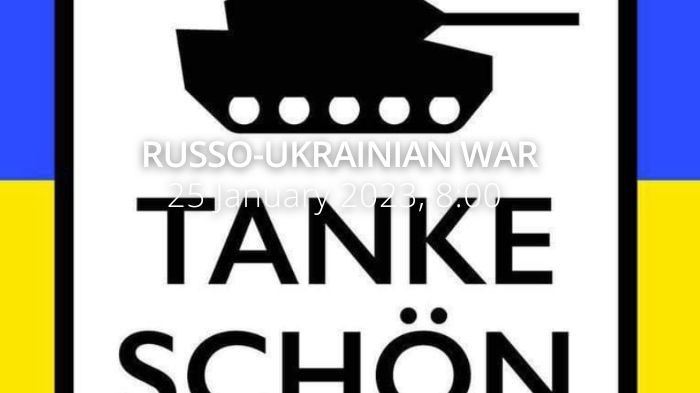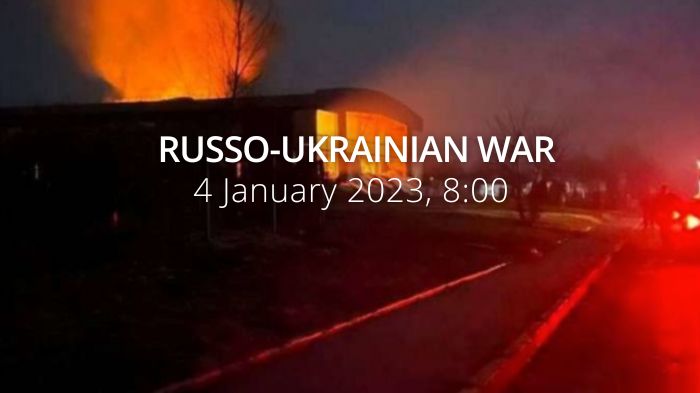31 Abrams tanks to Ukraine: an equivalent of one Ukrainian tank battalion - US President Biden. Ukraine is to receive 80 battle tanks from Europe. 12 countries (Poland, Germany, Portugal, Spain, Norway, Finland, Netherlands, Canada, and others) expressed willingness to transfer Leopard2 tanks. The coalition plans to form 2 full tank battalions (80 vehicles). Ukrainian forces withdrew from Soledar.
https://twitter.com/EuromaidanPress/status/1618330951742001152
Daily overview — Summary report, January 26, 2023
A map of the approximate situation on the ground in Ukraine as of 00:00 UTC 26/01/23.
There have been no notable changes to control since the last update. pic.twitter.com/ix7zgu8aAv
— War Mapper (@War_Mapper) January 26, 2023
The General Staff’s operational update regarding the Russian invasion as of 18.00 pm, January 26, 2023 is in the dropdown menu below:
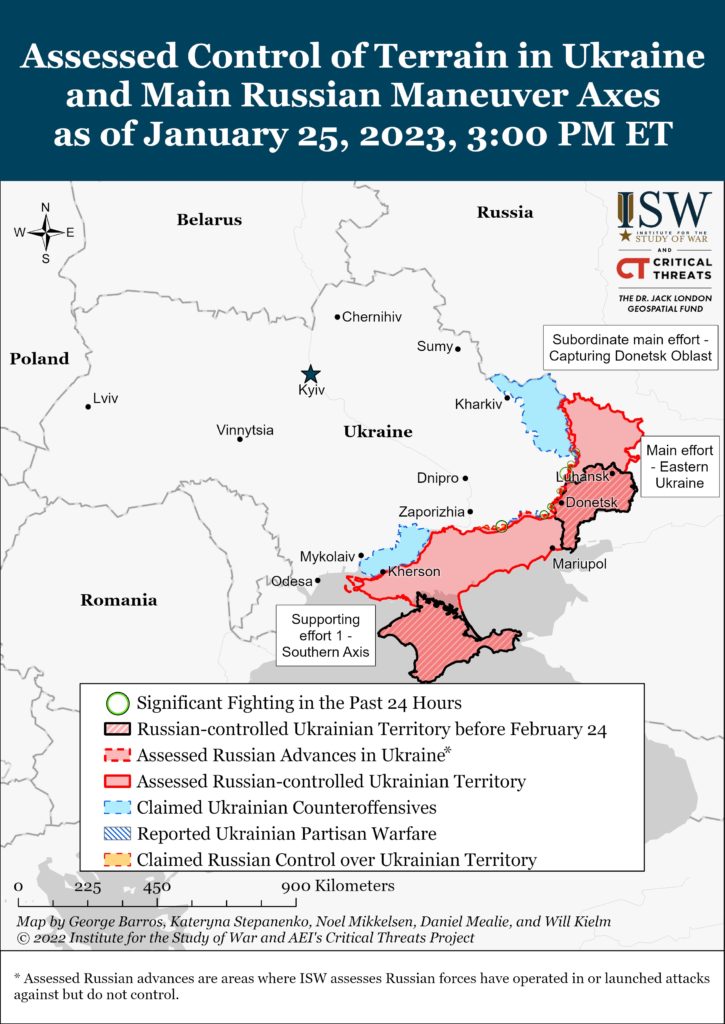
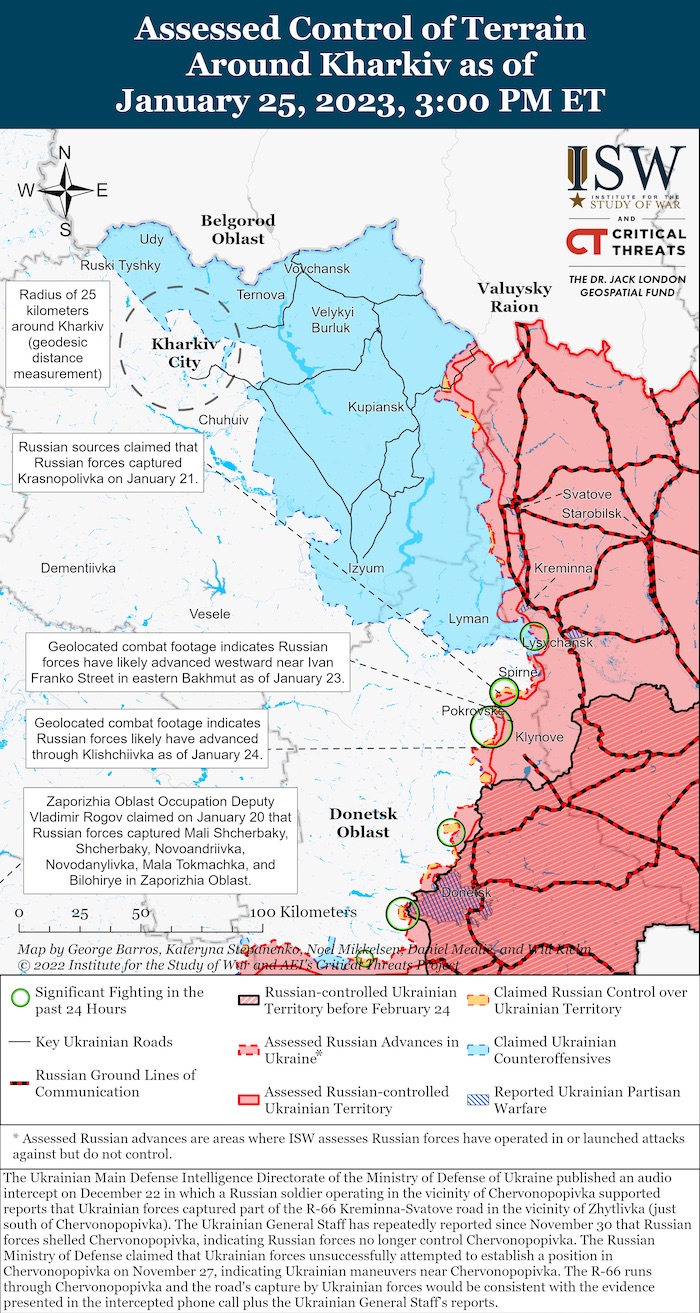
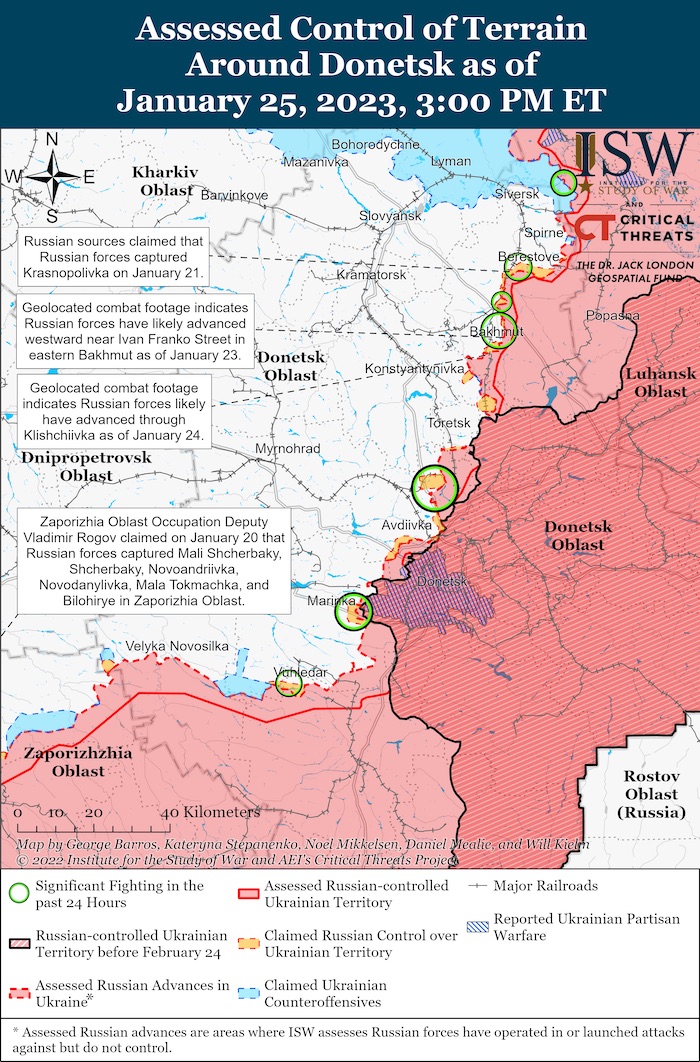
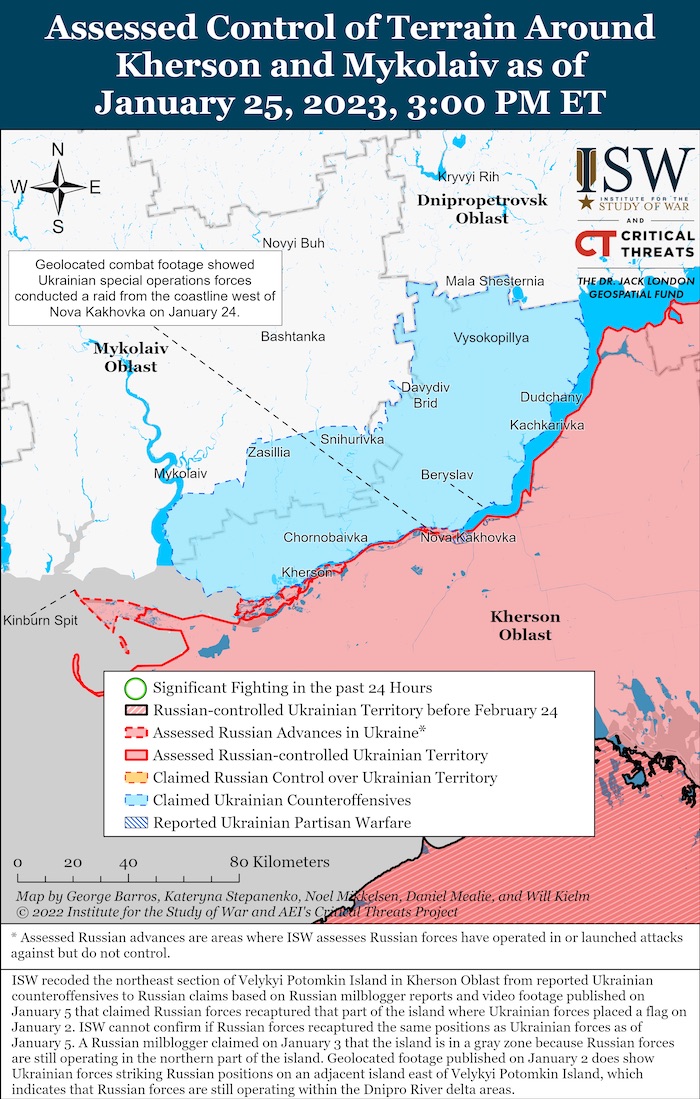
Military Updates
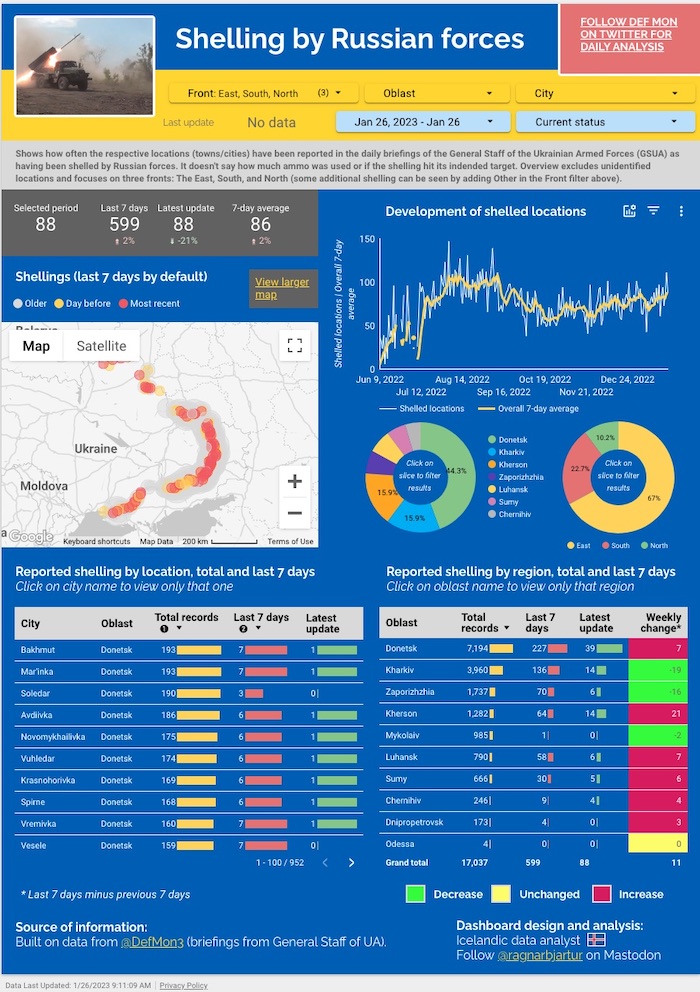
Ukraine forces have completely left Soledar in Donetsk Oblast. Ukraine’s forces have completely left the city of Soledar in Donetsk Oblast, Serhiy Cherevatyi, the spokesman for the eastern group of the Ukrainian Armed Forces, said. Cherevatyi’s direct speech: “In order to preserve the lives of the personnel, the Defense Forces moved away from Soledar and entrenched themselves on previously prepared defense lines.”
Captured Russian soldier will face trial for torturing civilians in Irpin in March
A suspected &his commander beat the victim in body & head, simulating a murder, shot him near the head several times. They were also spotted looting by surveillance cameras https://t.co/wrDX9Y9H86 pic.twitter.com/cUZxT7NzUx
— Euromaidan Press (@EuromaidanPress) January 25, 2023
Captured Russian soldier will face trial for torturing civilians. Investigators of the National Police of Ukraine have established that two Russian soldiers captured near Kherson in September 2022 were fighting in Ukraine’s Kyiv Oblast in March 2022 where they tortured civilians. In particular, police suspect a scout rifleman of the 1st battalion of the 104th regiment of the 76th division of the military unit 32515 of the Russian Federation and his commander.
https://twitter.com/EuromaidanPress/status/1618303007367565336
According to British Defence Intelligence, (last 48 hours):
https://twitter.com/DefenceHQ/status/1618249977527926784
- Russia has likely completed training of the 2nd Guards Motor Rifle Division (GMRD) in Belarus, which had been carrying out training since autumn 2022. The majority of the 2nd GMRD has now transferred back to Russia, before almost certainly being recommitted to operations in Ukraine.
- The 2nd GMRD is an element of the 1st Guards Tank Army and suffered major losses in the opening phases of the conflict. It is now primarily made up of mobilised personnel operating older equipment taken from storage. Its combat effectiveness will likely be limited despite several weeks of training.
- There is a realistic possibility that other Russian units are being rotated into Belarus for similar training, and that Russia will continue this model to regenerate and prepare units to maintain its force in Ukraine.
Losses of the Russian army
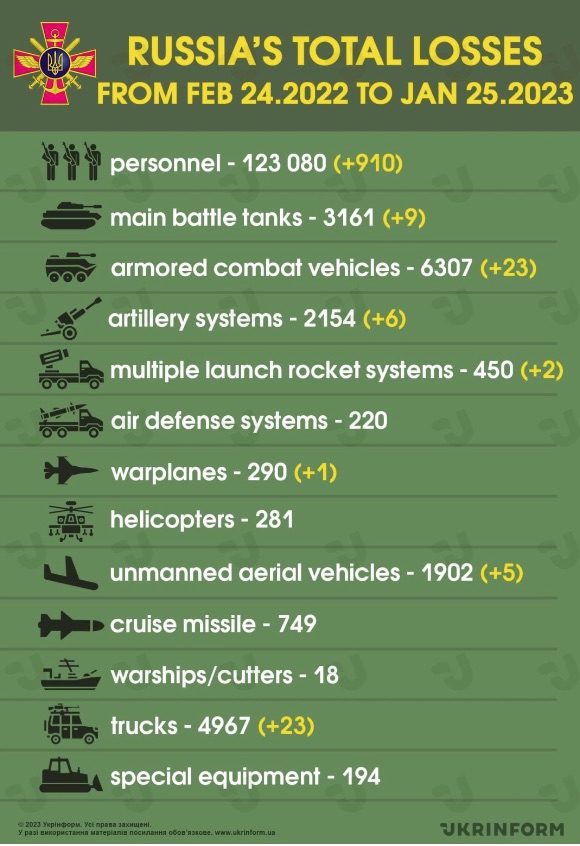
Humanitarian
https://twitter.com/EuromaidanPress/status/1618354124688433161
Ukrainian refugees: blow to Ukraine’s demography, godsend for the EU. The longer the war drags on, the more Ukrainian refugees — currently, approximately 1/5 of its population — will choose not to return. This is a mortal blow to Ukraine’s demography, but a godsend for EU countries, who face their own demographic and economic problems. Ukraine now grapples with losing millions of its well-educated middle-class citizens while the EU creates policies aimed at attracting them to remain abroad — a “marketing plot and calculation,” according to social scientist Kliuchkovska.
Ukrainian refugees: blow to Ukraine’s demography, godsend for the EU
Businesses fleeing war to west Ukraine find a new life and help the army. Novovolynsk, a small Ukrainian city of 50,000 residents near the Polish border, accepted 10,000 displaced persons and became a massive volunteer hub, making significant contributions to Ukraine’s military and civilian resistance. Euromaidan Press interviewed relocated businesses. A military unloading systems factory from the east of Ukraine moved here and now employs Ukrainians from across the country. Entrepreneurs, a family of Kyiv musicians, and a young barista from Odesa opened three new cafes, enriching the social life in Novovolynsk.
https://twitter.com/EuromaidanPress/status/1618351662753804289
Environmental
Scientists evacuated unique herbarium from Kherson. A unique herbarium, which had been collected for more than 50 years, was evacuated from Kherson State University. 32,000 valuable herbarium specimens were taken to Vasyl Stefanyk Prykarpattia National University. More than a thousand boxes were needed to take out valuable plants and mushrooms, the Ukrainian Nature Conservation Group (UNCG) reported in a comment to Ukrainska Pravda.
Legal
European Court established that Russia controlled Donbas since 2014. The European court of Human Rights ruled Ukraine cases against Russia admissible, AP reports. The court said evidence presented at a hearing last year established that from May 11, 2014, areas in eastern Ukraine were “under the jurisdiction of the Russian Federation” and that Moscow “had a significant influence on the separatists’ military strategy” including providing weapons, carrying out artill
Russian collaborator proposed a bribe to security officer and now faces additional term in prison. A resident of Snihurivka in Ukraine’s Mykolativ Oblast supported the Russian troops during the occupation and helped them sell the looted property of Ukrainians. Employees of the Security Service of Ukraine (SBU) detained the collaborator in the course of stabilization measures after the liberation of the Mykolaiv Oblast.
Ukraine’s Director of the procurement department of the Ministry of Defense dismissed. Ukraine’s Director of the procurement department of the Ministry of Defense Bohdan Khmelnytskyi was also dismissed. He signed the contract on food procurement with mistakes that sparked outrage in Ukraine. An investigation against him is ongoing. As was earlier reported, the deputy defense minister responsible for procurement has also resigned.
Top Ukrainian officials resign in an anti-corruption drive. On 23 January, Ukrainian President Volodymyr Zelenskyy announced personnel changes in ministries, government structures, and the judicial system. The day after the statement, Presidential Office said it had accepted the resignation of Kyrylo Tymoshenko, as its deputy’s head.
Support
Ukraine is to receive 80 battle tanks from Europe
12 countries (Poland, Germany, Portugal, Spain, Norway, Finland, Netherlands, Canada,&others) expressed willingness to transfer Leopard2 tanks. Coalition plans to form 2 full tank battalions (80 vehicles) https://t.co/lYOZtc1dnJ pic.twitter.com/VUMJfrcWYF
— Euromaidan Press (@EuromaidanPress) January 25, 2023
US to send 31 Abrams tanks to Ukraine – Biden. On 25 January, US President Joe Biden announced plans to send 31 Abrams tanks to Ukraine with spare parts and equipment to sustain them. Biden said: “Today I am announcing that the United States will be sending 31 Abram tanks to Ukraine, the equivalent of one Ukrainian battalion. [Defense] Secretary Austin has recommended this step because it will enhance Ukraine’s capacity to defend its territory and achieve its strategic objectives. The Abrams tanks are the most capable tanks in the world and they’re also extremely complex to operate and maintain. So we’re also giving Ukraine the parts and equipment necessary to effectively sustain these tanks on the battlefield. We’ll begin to train the Ukrainian troops on these issues of sustainment logistics and maintenance as soon as possible. Delivering these tanks to the field is going to take time. Time that we’ll see and we’ll use to make sure the Ukrainians are fully prepared to integrate the Abrams tanks into their defenses.”
Ukraine is to receive a total of 80 battle tanks from Europe. European countries want to provide Ukraine with main battle tanks for two battalions, the USA is equipping another, Spiegel reports. The German tanks could be delivered by the end of March. 12 countries (Poland, Germany, Portugal, Spain, Norway, Finland, the Netherlands, Canada, and others) expressed their willingness to transfer Leopard 2 tanks to Ukraine. In the near future, the coalition plans to form 2 full-fledged tank battalions (80 combat vehicles) for the Armed Forces of Ukraine.
Germany’s Leopard tanks will arrive in Ukraine in 3–4 months. Germany said on Wednesday it would supply its Leopard 2 tanks to Ukraine. Germany’s tanks would probably be ready in three-four months, Defence Minister Boris Pistorius said, Tagesschau reports.
Ukrainian Foreign Minister hints they are already working towards the supply of F16 after Germany approved Leopard 2s. Ukrainian Minister of Foreign Affairs Dmytro Kuleba wrote about this on Facebook: “– Now F16? – Yes. – Taking to work, friend. I just received a question from a European colleague. And answered him. He knows what to do. And you should know that no matter how difficult it is, you should never give up. No matter how sad it is, do not despair. No matter how hard the enemies try, they will die like dew from the sun. It’s necessary always to believe and work hard. And everything will be. Because Ukraine can do everything.“ As was reported on 24 January, Germany has decided to send at least one company of the Leopard 2A6 main battle tanks to Ukraine and approve reexport from other countries.
Norway considers the transfer of up to 8 Leopard 2 tanks to Ukraine. European Pravda reports, referencing Norwegian publication Dagens Næringsliv, Norway is considering supplying Ukraine with up to eight Leopard 2 tanks from 36 available. According to the publication, the Norwegian government will soon decide to procure new tanks. Norway held a closed meeting of the Foreign Affairs and Defense Committee on Monday evening to discuss military assistance to Ukraine.
https://twitter.com/EuromaidanPress/status/1618342945676992514
Slovakia ready to discuss the transfer of its MiG-29 fighters to Ukraine. Slovakia is ready to discuss the transfer of its MiG-29 fighters to Ukraine, Slovak Defense Minister Jaroslav Nagy announced during an online briefing in the media center “Odesa-Ukraine” as Ukrinform reports.
New Developments
The US will increase sixfold the production of 155-mm shells, incl. to supply Ukraine. Production of the 155-millimeter shells in the US will rise sixfold, to 90,000 a month in two years, the Army’s top acquisition official said according to the New York Times. It is part of “the most aggressive modernization effort in nearly 40 years” for the US defense industrial base, according to an Army report.
Ukrainian Commander in Chief Zaluzhnyi donated USD 1 million to the army from inheritance. The Commander in Chief of Ukraine’s Army, General Valeriy Zaluzhnyi donated $1 million to the military from an inheritance he received from a Ukrainian American, Gregory Stepanets, the New York Times reported.
Ukraine completes planning for the Bayraktar manufacturing plant. European Pravda reports, referencing the briefing at the Media Center Ukraine – Ukrinform, that according to the Ambassador of Ukraine to Türkiye, Vasily Bodnar, the project for the manufacturing plant to produce Turkish drones Bayraktar TB2 has been completed. Additionally, the necessary legal framework has been established.
Vladimir Putin’s war is turning Russia into a failed state, with uncontrolled borders, private military formations, a fleeing population, moral decay and the possibility of civil conflict
— The Economist (@TheEconomist) December 19, 2022
Assessment
- On the war.
The Institute for the Study of War has made the following assessment as of January 25, 2023:
Russian forces may be engaging in limited spoiling attacks across most of the frontline in Ukraine in order to disperse and distract Ukrainian forces and set conditions to launch a decisive offensive operation in Luhansk Oblast. Russian forces have re-initiated offensive operations, namely limited ground attacks, on two main sectors of the front in the past few days—in central Zaporizhzhia Oblast along Kamianske-Mali Shcherbaky-Mala Tokmachka line and in the Vuhledar area of western Donetsk Oblast.[1] Ukrainian officials have noted that these attacks are conducted by small squad-sized assault groups of 10 to 15 people and are aimed at dispersing Ukrainian defensive lines.[2] The size and nature of these attacks suggest that they are more likely spoiling attacks that seek to distract and pin Ukrainian forces against discrete areas of the front than a concerted effort to relaunch offensive operations to gain ground in the central Zaporizhzhia and western Donetsk directions.
These limited attacks are notably ongoing as the pace of Russian operations around Bakhmut, led by the Wagner Group, seems to be decreasing. Following the Russian capture of Soledar in mid-January, the attacks on Bakhmut and surrounding settlements have apparently dropped off, suggesting that the Russian offensive operation to take Bakhmut may be culminating. The Wagner Group has failed to deliver on its promise of securing Bakhmut and has been unable to progress beyond minor tactical gains in Soledar and other surrounding small settlements. Russian military leadership may have, therefore, decided to de-prioritize operations around Bakhmut after recognizing the low likelihood that Wagner will actually be able to take the settlement. As ISW has previously suggested, Russian sources may be pushing the narratives of claimed Russian offensive operations in central Zaporizhzhia and western Donetsk Oblast in order to inflate the Russian information space with positive narratives that compensate for abject failures around Bakhmut.[3] Both the information space effects and the attacks themselves may be intended to distract focus from the lack of gains in Bakhmut and draw Ukrainian forces to the areas in question.
The Russian military appears to be shifting its focus towards conventional forces and away from the non-traditional force structure of the Wagner Group, potentially in preparation for a decisive effort in Luhansk Oblast. On the strategic level, certain changes to Russian command reflect a gradual transition away from reliance on unconventional force groupings such as Wagner and towards supporting and empowering conventional Russian elements. The recent appointment of Chief of the General Staff Army General Valery Gerasimov to overall theater command of Russian forces in Ukraine (and subsequent demotion of Wagner Group favorite Army General Sergey Surovikin) suggests that Russian military leadership is increasingly looking to the traditional and conventional military establishment that Gerasimov represents and leads. The Russian Ministry of Defense (MoD) has similarly engaged in efforts to reform and standardize the conventional military in line with Gerasimov’s appointment.[4] Russian President Vladimir Putin appears to be empowering Gerasimov to take steps that undermine Wagner Group financier Yevgeny Prigozhin and the unconventional force structure he represents.[5] The shift toward conventional forces is also increasingly apparent on the operational and tactical levels. Various conventional elements (namely from the 3rd Motor Rifle Division and Airborne Forces) have been arrayed across the Svatove-Kreminna line in Luhansk Oblast and are notably not supporting Wagner Group operations around Bakhmut, indicating that Russian military leadership may be allocating conventional forces to what they regard as a more promising axis of advance.[6] Ukrainian intelligence relatedly noted that elements of the 2nd Motor Rifle Division of the 1st Guards Tank Army of the Western Military District have withdrawn from Belarus and partially deployed to Luhansk Oblast.[7]
The array of conventional forces across the Luhansk Oblast frontline suggests that Russian forces may be preparing for a decisive effort in this sector, supported by limited spoiling attacks elsewhere on the frontline to distract and disperse Ukrainian forces. ISW has previously discussed indicators of a potential decisive Russian effort in Luhansk Oblast.[8] Taken in tandem with a variety of intelligence statements that Russia is preparing for an imminent offensive operation in the coming months, it is likely that a decisive effort in Luhansk Oblast would be an offensive one.[9] The most probable course of a Russian offensive action in Luhansk Oblast would be premised on launching an attack along the Svatove-Kreminna line, supported by critical ground lines of communication (GLOCs) that run into major logistics hubs in Luhansk City and Starobilsk, in order to reach the Luhansk Oblast administrative border and complete the capture of the remaining part of Luhansk Oblast that is still Ukrainian-controlled. Russian forces may hope to recapture critical ground in northern Donetsk Oblast around Lyman and use the Svatove-Kreminna line to launch further attacks into western Kharkiv and/or northern Donetsk Oblasts. Russian forces are exceedingly unlikely to be able to gain substantial ground on this axis even if they do launch a successful offensive operation on this sector, however.
The Kremlin and Russian milbloggers attempted to play down the Western provision of tanks to Ukraine, indicating that they likely find these systems threatening to Russian prospects. Kremlin spokesperson Dmitry Peskov stated on January 25 that the Western provision of Abrams and Leopard tanks to Ukraine is "quite a failure … in terms of technological aspects" and that there is a "clear overestimation of the potential that [these tanks] will add" to Ukrainian forces.[10] Some Russian milbloggers likely sought to reassure their domestic audiences by claiming that these systems do not pose a significant threat and that previous Western systems like HIMARS are a far more serious threat.[11] The Kremlin and Russian milbloggers previously framed the Western provision of purely defensive Patriot missile systems as a serious escalation between Russia and the West.[12] The fact that the Kremlin and Russian milbloggers did not frame the provision of armored vehicles that could actually aid future Ukrainian counteroffensive operations as escalatory suggests that the Kremlin and the Russian information space continue to selectively choose which systems to frame as an escalation. The Kremlin and Russian milbloggers seem more concerned in this case with calming potential fears of the impact of Western commitments to supply Ukraine with tanks than with feeding the escalation narrative in the West. The Kremlin and its allies are right to be concerned about these new Western commitments, which allow Ukrainian commanders to plan against replacements for tank losses they could expect in counter-offensive operations that might be launched even before the Western tanks begin to arrive.
Key Takeaways
- Russian forces may be engaging in limited spoiling attacks across most of the frontline in Ukraine in order to disperse and distract Ukrainian fronts and launch a decisive offensive operation in Luhansk Oblast.
- The Russian military appears to be shifting its focus toward conventional forces deployed to Luhansk Oblast and away from the non-traditional force structure of the Wagner Group and its focus on Bakhmut.
- The Kremlin and Russian milbloggers attempted to downplay the Western provision of tanks to Ukraine, indicating that they likely find these systems threatening to Russian prospects.
- Russian forces claimed that Ukrainian forces conducted counteroffensive operations near Svatove as Russian forces continued limited ground attacks near Kreminna.
- Ukrainian forces have likely made advances around Kreminna.
- Ukrainian officials acknowledged that Ukrainian forces withdrew from Soledar.
- Russian forces continued offensive operations in the Bakhmut and Avdiivka-Donetsk City area. Russian forces reportedly continued localized offensive operations near Vuhledar.
- Russian forces continued to conduct small-scale ground attacks across the Zaporizhzhia Oblast front line, likely to attempt to fix Ukrainian forces in Zaporizhzhia Oblast.
- Russian milbloggers are divided over the veracity of Zaporizhzhia Oblast occupation official Vladimir Rogov’s ongoing, overblown information operation.
- The Kremlin is attempting to downplay new restrictions on crossing the Russian border, likely in an effort to contain panic within Russian society about a likely second mobilization wave.
- Russian President Vladimir Putin may be attempting to conduct another wave of mobilization discreetly out of concern for undermining his support among Russians.

